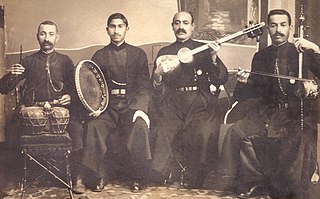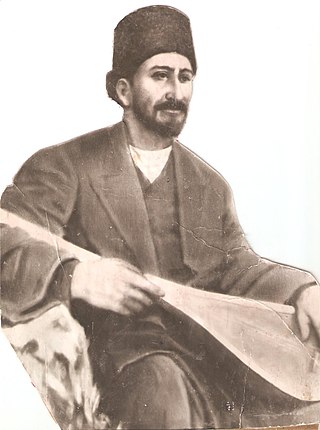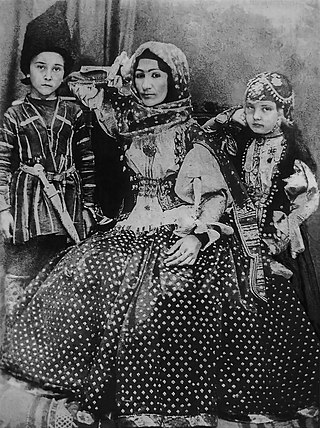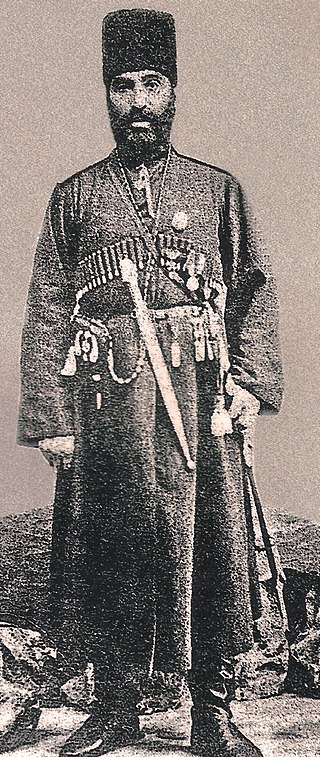Related Research Articles

Azerbaijani literature is written in Azerbaijani, a Turkic language, which is the official state language of the Republic of Azerbaijan, where the North Azerbaijani variety is spoken. It is also natively spoken in Iran, where the South Azerbaijani variety is used, and is particularly spoken in the northwestern historic region of Azerbaijan. Azerbaijani is also spoken natively in Russia, Georgia and Turkey. While the majority of Azerbaijani people live in Iran, modern Azerbaijani literature is overwhelmingly produced in the Republic of Azerbaijan, where the language has official status. Three scripts are used for writing the language: Azerbaijani Latin script in the Republic of Azerbaijan, Arabic script in Iran and Cyrillic script formerly used in Soviet Azerbaijan.

Shusha or Shushi is a city in Azerbaijan, in the region of Nagorno-Karabakh. Situated at an altitude of 1,400–1,800 metres (4,600–5,900 ft) in the Karabakh mountains, the city was a mountain resort in the Soviet era.

Jabrayil District is one of the 66 districts of Azerbaijan. It is located in the south-west of the country and belongs to the East Zangezur Economic Region. The district borders the districts of Khojavend, Fuzuli, Qubadli, Zangilan, and the Islamic Republic of Iran.

Shusha District is one of the 66 districts of Azerbaijan. It is located in the west of the country and belongs to the Karabakh Economic Region. The district borders the districts of Khojaly, Lachin, and Khojavend. Its capital and largest city is Shusha. As of 2020, the district had a nominal population of 34,700. Finally villages of Malıbəyli, Aşağı Quşçular and Yuxarı Quşçular were transferred to Khojaly District according to passing law in 5 December 2023.

Mugham or Mughamat is one of the many classical compositions from Azerbaijan, contrasting with tasnif and ashik.

Khurshidbanu Natavan was an Azerbaijani poet and philanthropist. She is considered one of the best lyrical poets of Azerbaijan. Her poems are in either Azerbaijani or Persian and she was most notable for her lyrical ghazals.

Molla Panah, better known by his pen-name Vagif, was an 18th-century Azerbaijani poet, statesman and diplomat. He is regarded as the founder of the realism genre and the modern school in Azerbaijani poetry. He served as the vizier—the minister of foreign affairs—of the Karabakh Khanate during the reign of Ibrahim Khalil Khan.

An ashik or ashugh is traditionally a singer-poet and bard who accompanies his song—be it a dastan or a shorter original composition—with a long-necked lute in Azerbaijani culture, including Turkish and South Azerbaijani and non-Turkic cultures of South Caucasus. In Azerbaijan, the modern ashik is a professional musician who usually serves an apprenticeship, masters playing the bağlama, and builds up a varied but individual repertoire of Turkic folk songs.

Gasim bey Zakir was an Azerbaijani poet of the 19th century and one of the founders of the critical realism and satirical genre in Azerbaijani literature. He is considered to be the foremost Azerbaijani poet and satirist of the first half of the 19th century, and the greatest master of 19th-century comic poetry in Azerbaijani.

Ashig Alasgar was an Azerbaijani mystic troubadour (Ashik) and highly regarded poet of Azerbaijani folk songs. He was born in the village of Aghkilsa in the Goycha District of the Erivan Khanate.
Aziza Mammed qyzy Jafarzade (Azerbaijani: Cəfərzadə Əzizə Məmməd qızı was an Azerbaijani writer and professor of philology. She was an expert on the history of Azerbaijani literature.

The Javanshirs are a Turkic clan from Karabakh, who are a branch of the Oghuz Turks. Between 1748 and 1822, members of the Javanshir clan functioned as the head of the Karabakh Khanate.

Mehdigulu Khan Utsmiyev was a lyrical poet of Azerbaijan of Kumyk and Javanshir descent, a lieutenant colonel in the Imperial Russian Army. He authored poetry under pseudonym Vafa.

The art of Azerbaijani Ashiqs combines poetry, storytelling, dance, and vocal and instrumental music into traditional performance art. This art is one of the symbols of Azerbaijani culture and considered an emblem of national identity and the guardian of Azerbaijani language, literature and music.

Jafargulu aghaJavanshir was an Azerbaijani poet, figure and a major-general of the Russian Army.
Khasta Qasim – was an Iranian Azerbaijani poet of Azerbaijani literature. Khasta Qasim was one of the best Azerbaijani-language poets; he was also a mystic, ashik, and philosopher in the era of Afsharid Iran, popularly known as Dada and Gasim.
Ashik Qurbani or Kurbani was an Azerbaijani ashik.

Turkish hikaye is a narrative genre, which is a mixture of prose and poetry. Prose, the dominant part is narrated by an ashik and is interspersed with poems sung by the same artist to the accompaniment of saz.
Bayati is one of the oldest forms of Azerbaijani folk poetry. A bayati consists of four lines, each of which has seven syllables. The rhyme scheme is AABA. Anonymous bayati have been collected as folk wisdom in editions such as Azerbaijani: Xalqimizin deyimlari va duyumlari. Bayati can also be strung together in sequence to form longer poems, and there are several bayati dastan, epics, in which all of the verses are bayati; one example is Arzu-Qamber.
Zarnigar Derbentli is an Azerbaijani female ashiq and one of the prominent representatives of the female ashiq school of Azerbaijan in the 18th - 19th centuries.
References
Citations
- 1 2 3 Oldfield 2021, p. 55.
- 1 2 3 Oldfield 2021, p. 48.
- 1 2 Bayraktarlar 2014; Oldfield 2021, p. 48.
- 1 2 3 4 5 6 Heß 2016.
- ↑ Bayraktarlar 2014; Heß 2016; Oldfield 2021, p. 48.
- 1 2 Gray 2009; Heß 2016.
- 1 2 3 4 Bayraktarlar 2014.
- 1 2 Oldfield 2021, p. 49.
- ↑ Oldfield 2021, p. 50.
- ↑ Bayraktarlar 2014; Oldfield 2021.
- ↑ Bayraktarlar 2014; Gray 2009; Oldfield 2021, p. 53.
Sources
- Bayraktarlar, Tuğba (2014). "Peri". Türk Edebiyatı İsimler Sözlüğü (in Turkish). Ahmet Yesevi University . Retrieved 29 July 2023.
- Gray, Laurel Victoria (2009). "Arts: Folk Dancers and Folk Singers: Caucasus". In Joseph, Suad (ed.). Encyclopedia of Women and Islamic Cultures . Brill Online. doi:10.1163/1872-5309_ewic_EWICCOM_0291b . Retrieved 29 July 2023.
- Heß, Michael R. (2016). "Aşıq Pəri". In Fleet, Kate; Krämer, Gudrun; Matringe, Denis; Nawas, John; Stewart, Devin J. (eds.). Encyclopaedia of Islam (3rd ed.). Brill Online. doi:10.1163/1573-3912_ei3_COM_24977 . Retrieved 29 July 2023.
- Oldfield, Anna C. (2021). ""Don't Get in my Face Like Ashiq Peri"". In Jussawalla, Feroza; Omran, Doaa (eds.). Memory, Voice, and Identity: Muslim Women's Writing from across the Middle East. New York: Routledge. ISBN 9781003100164.